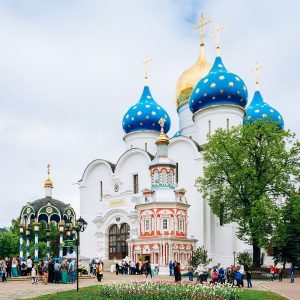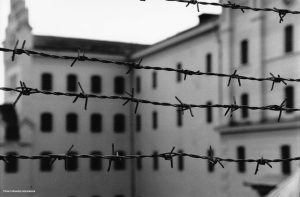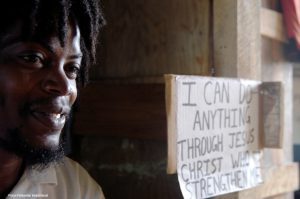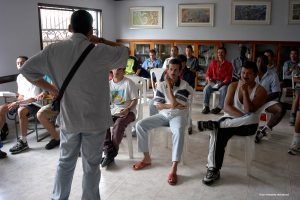Hope in the Dark
Amid all the bleak news about America’s racial divide, I came across a remarkable video on a spiritual awakening in the largest maximum-security prison in the country. The documentary, produced by The Atlantic magazine, takes thirteen minutes to watch, and I hope you do so. (Click on this LINK and look for the large white “Play” button.) It reminded me that God’s work can thrive in the most unlikely places.
For several decades I’ve supported Prison Fellowship International, founded by Chuck Colson, which now has branches in 120 countries. Its 45,000 volunteers provide down-to-earth services, such as supplying poor inmates with food and medicine, and educating the children of incarcerated mothers. In several countries the government has actually asked PFI to take over the management of prisons.
As a journalist, I’ve seen the work of PFI firsthand. Not long after the fall of Communism in Russia, I attended two Sunday services in the monastery town of Zagorsk. The first took place in a cathedral within the grounds of the monastery, which is celebrated as the richest jewel of the Russian Orthodox Church. I sat before a wall covered with gold and inset with icons, listening to a 150-voice choir composed entirely of young monks in training. The air hummed with the throaty, bass-clef harmony of the Russian liturgy, a sound that seemed to come from under the floor.
An hour later I found myself in the basement of a dungeon built in 1832. We had passed through four steel gates to reach the prisoner’s cells on the bottom level, the stench growing worse with each step. In cells smaller than my bedroom, eight teenage boys lived, two to a bed. A ceramic-lined hole in the ground served as both toilet and “shower,” although the only water came from a cold-water spigot an arm’s length away. There were no board games, no television sets, no diversions of any kind. All day every day for a year, two years, maybe five, these boys had nothing to do but lie on their beds or pace around the room. For security purposes, the Zagorsk prison enforces a 24-hour lockdown.
 During the last years of the crumbling Soviet Union, priests from the monastery had donated enough bread and vegetables to feed the prisoners throughout the winter. As a result, the warden, a dedicated communist, authorized them to build a chapel in the prison basement—a bold act for a communist functionary in the atheistic state of those days.
During the last years of the crumbling Soviet Union, priests from the monastery had donated enough bread and vegetables to feed the prisoners throughout the winter. As a result, the warden, a dedicated communist, authorized them to build a chapel in the prison basement—a bold act for a communist functionary in the atheistic state of those days.
Located on the lowest subterranean level, the chapel was an oasis of beauty in an otherwise grim place. After the prisoners had cleaned out a seventy-year accumulation of filth from an old storeroom, the monks installed a marble floor and mounted finely wrought candle sconces on the walls. The inmates took pride in their handiwork which, they said, was the only prison chapel in all of Russia. Each week priests traveled from the monastery to conduct a service there, and for this occasion prisoners were allowed out of their cells, which guaranteed excellent attendance. One of the monks pointed to the icon for the prison chapel: “Our Lady Who Takes Away Sadness.”
On another trip I visited PFI’s work in Peru and Chile. In contrast to the formality of Russian Orthodoxy, the church service here had a distinctly Latin and Pentecostal flavor. A worship band comprised eighteen guitarists, one accordionist, and two men wielding handmade brass tambourines. The congregation, 150 strong, lustily joined in, with some inmates raising their hands above their heads and some apparently competing in a highest-decibel contest. The meeting room was overflowing, and extra faces peered in all the windows. I looked around at the congregation: all men, wearing a ragtag assortment of handed-down street clothes. A shocking number of their faces were marked with scars.
One of the band members, a short, wiry man with a thick scar running across his left cheek, spoke first. “They used to think I was so dangerous that they kept me in chains. And I’ll tell you why I first started going to prison church—I was looking for an escape hole!” Everyone laughed, even the guards. “But there I found true freedom in Christ, not just a way to escape.”
 Another prisoner limped to the front. He explained that he had lost a leg and most of his bowels in a shooting incident in an Argentine prison. He became a Christian behind bars. Later, he confronted the man who had killed his brother. “Before, I would have killed that man,” he says. “But with God’s help I was able to forgive him. Now I know I am called to preach to the others here in prison. It’s a more important job than being President of General Motors. And with thirty-four years to go on my sentence, I’ll have plenty of time!”
Another prisoner limped to the front. He explained that he had lost a leg and most of his bowels in a shooting incident in an Argentine prison. He became a Christian behind bars. Later, he confronted the man who had killed his brother. “Before, I would have killed that man,” he says. “But with God’s help I was able to forgive him. Now I know I am called to preach to the others here in prison. It’s a more important job than being President of General Motors. And with thirty-four years to go on my sentence, I’ll have plenty of time!”
We stayed for at least two hours, with the service still gathering emotional steam. Prisoners spontaneously knelt by the rough wooden benches to pray for their fellow inmates. The singing, animated with hand-clapping and foot-stomping, grew louder and more boisterous. Other prisoners abandoned their basketball games and crowded around the open doorway to see what they were missing. When I and the other foreign visitors left, amid many hugs and handshakes, all the prisoners stayed. They were just getting warmed up.
On the way back to our hotel, Ron Nikkel, then president of Prison Fellowship International, reflected on our day. “It never fails to get to me, no matter how many prisons I visit,” he said. “To see human beings in such miserable conditions, and yet praising God. In their faces you can see a joy and love like I’ve encountered nowhere else. I wish some of the dispirited Christians back in North America could travel with me and see the difference Christ can make in a person’s life. God chooses the weak and foolish things of the world to confound the wise and the mighty.”
Ironically, Ron sees the failure of penal systems around the world as a boon for ministry. “Marxists fail at their prisons, as do Muslims, Hindus, and secular humanists. Nothing works. Societies shut prisoners out of sight because they’re an embarrassment, an admission of failure. But they let prison ministries in, figuring we can’t worsen an already hopeless situation. And there, behind those bars in the least likely of all places, the church of God takes shape. In South Africa one brave couple started a series of Bible studies in the most violent prison in Africa. Within a year the annual incidence of violent attacks in that prison dropped from 279 to two. Wardens notice results like that.
 “It’s a New Testament church in its purest form. Chile, for example, has five thousand different denominations and church groups. But in Chilean prisons, the Christians are one. Prison abolishes all the normal distinctions of denomination and race and class. I can’t give details on some of the most exciting frontiers. I can only say that in societies so closed that they apply the death penalty for a conversion to Christianity, prisons are opening doors to us. Nothing else has worked in those prisons, so in desperation they turn to the Christians.”
“It’s a New Testament church in its purest form. Chile, for example, has five thousand different denominations and church groups. But in Chilean prisons, the Christians are one. Prison abolishes all the normal distinctions of denomination and race and class. I can’t give details on some of the most exciting frontiers. I can only say that in societies so closed that they apply the death penalty for a conversion to Christianity, prisons are opening doors to us. Nothing else has worked in those prisons, so in desperation they turn to the Christians.”
Ron pointed out that prison ministry is especially strategic in authoritarian countries, where potential leaders may be serving time right now. After South Africa’s changeover from the apartheid regime, a majority of the new cabinet had prison records. Think of Nelson Mandela, Alexander Solzhenitsyn, Elie Wiesel, Vaclav Havel, Aung San Suu Kyi, Benigno Aquino, Martin Luther King Jr. Annealed by their experience behind bars, each emerged with moral authority and an iron determination for justice.
Prison need not be a dead end of despair. One of the Bible’s most inspiring stories tells of Joseph, falsely accused and persecuted, who later rose to become the second most powerful person in the known world. The prophets Daniel and Jeremiah spent time in prison, and the apostle Paul wrote some of his most powerful letters there.
The United States, with 5 percent of the world’s population, holds almost a quarter of the world’s prisoners. We lock in drug offenders with murderers and thieves, creating a perfect breeding ground for ever more crime. Thirty-seven states have a higher rate of incarceration than any other country—including places like China, Russia, Iran, Cuba, Mexico, and Saudi Arabia.
The state of Louisiana wins the dubious prize of the world’s prison capital, imprisoning more of its people, per head, than any place on earth. It seems an endless cycle of despair—until something happens such as what caught The Atlantic’s attention at Angola Prison in Louisiana. There, as in the other prisons I have visited, wise leaders and ordinary volunteers are bringing a message of hope to a very dark place. “In desperation they turn to the Christians,” as Ron Nikkel said. And light breaks out.
 Even today, Jesus the former prisoner makes his home behind bars. “I was in prison and you came to visit me,” he said in one of his best known parables (Matthew 25).
Even today, Jesus the former prisoner makes his home behind bars. “I was in prison and you came to visit me,” he said in one of his best known parables (Matthew 25).
“When did we see you sick or in prison and go to visit you?”
And the King replied, “I tell you the truth, whatever you did for one of the least of these brothers of mine, you did for me.”

The post Hope in the Dark appeared first on Philip Yancey.



